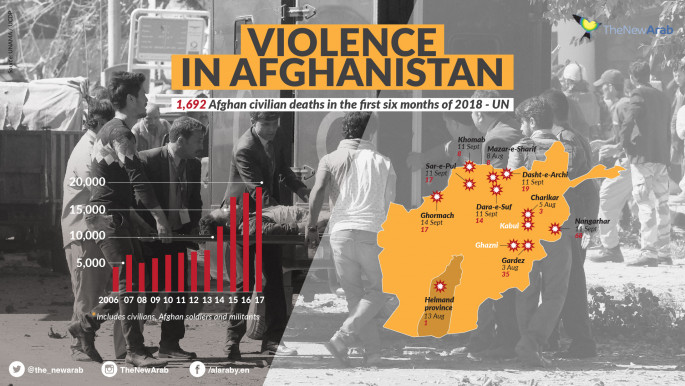Afghan journalists reporting war dying in record numbers
Moments after Afghan journalist Samim Faramarz wrapped up his live report on the latest suicide attack in Kabul, a car bomb exploded just metres away, killing him and his cameraman Ramiz Ahmadi.
Their colleagues at Tolo News choked back tears as they reported the deaths live on air - cracking open a divisive debate on how Afghan journalists should operate in such a dangerous environment.
The deaths of Faramarz and Ahmadi on September 5 took the number of journalists and media workers killed in Afghanistan this year to 14, making the country the deadliest in the world for the media.
Among the dead were 13 journalists - the highest number killed in Afghanistan in a single year since the start of the war.
The losses have devastated the tight-knit community that faces the real prospect of tragedy every time they go to work.
"When we leave our homes we don't know whether we will go back alive," said 1TV reporter Hamid Haidary, who keeps a photo shrine of fallen journalists on a shelf above his desk.
Haidary had gone to the scene of the explosion that killed Faramarz and Ahmadi, but returned to his office minutes before the second bomb detonated.
 |
|
"It is already too much for us," agreed Lotfullah Najafizada, director of Tolo, which is Afghanistan's largest private broadcaster.
As security in Afghanistan continues to deteriorate, the fear and anxiety is ever-present, he added.
"It is not just about the blast site, it is going to a province, it is coming to the office or being in the office - they all are attached to risks and it is difficult sometimes to minimise all of them to zero."
Sixty journalists and media workers have been killed in Afghanistan since the US-led invasion in 2001 that toppled the Taliban regime and enabled independent media to blossom in its wake - an average of around three a year, according to Reporters Without Borders (RSF).
Afghan media support group NAI gave an even higher toll of 95.
But the departure of NATO combat troops at the end of 2014 marked a turning point, RSF figures show: 39 journalists and media workers - over half of the total - have been killed since then as a resurgent Taliban and the newly-emerged Islamic State group terrorise the country.
Media outlets have already scaled back coverage on the battlefield. But until this year, suicide attacks in urban centres remained a staple for newsrooms.
A double bomb attack in the Afghan capital on April 30 changed that.
Nine journalists were killed in the twin blasts - the most lethal attack on the media since the fall of the Taliban.
Less than three months later AFP driver Mohammad Akhtar was killed in another suicide attack on his way to work, followed in September by Faramarz and Ahmadi.
The deaths are forcing outlets to ask themselves hard questions about how they work, especially as the country braces for more violence ahead of parliamentary elections in October.
Who’s to blame?
Much of the blame for the journalist deaths has been heaped on the Afghan government and its beleaguered security forces for failing to protect them.
But media outlets also have been criticised for repeatedly putting their staff in danger.
"Losing journalists in similar events one after another and not learning from the mistakes is bad management both on the part of the media organisations and the government," said Sayed Ikram Afzali, executive director of Afghan advocacy group Integrity Watch.
Militants make headlines for killing civilians, security forces and first responders, including journalists.
But a total ban on covering suicide attacks "would be disrespecting the fallen", said BBC bureau chief Shoaib Sharifi.
The British broadcaster goes to great lengths to minimise the risks. "We literally evaluate and monitor every step outside the office," he said.
For now Afghan broadcaster 1TV, which has had several people killed or wounded in this year's bombings, will continue to go to the scene of suicide attacks, said head of news and current affairs Abdullah Khenjani.
"I think people deserve to know what is happening in their country," he added.
But they no longer rush to be the first at the scene, and wearing flak jackets and helmets is mandatory.
The New York Times' "default position is 'don't go' unless ... we agree there is some exceptional reason why you should," bureau chief Rod Nordland said.
"In most cases we're saying there is no exceptional reason."
The newspaper instead goes to hospitals or the homes of victims' families to show the human suffering caused by such attacks, as it continues to seek ways of telling the story even without going to the scene.
"The risk now of going to a bomb site, of getting hit by a second bomb... outweighs the journalistic value in doing that," Nordland said.





 Follow the Middle East's top stories in English at The New Arab on Google News
Follow the Middle East's top stories in English at The New Arab on Google News
![Israeli forces ordered bombed Gaza's Jabalia, ordering residents to leave [Getty]](/sites/default/files/styles/image_330x185/public/2176418030.jpeg?h=a5f2f23a&itok=_YGZaP1z)

